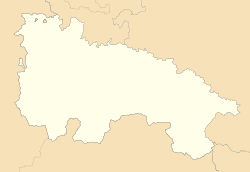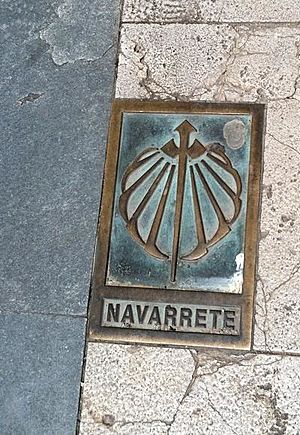Navarrete, La Rioja facts for kids
Quick facts for kids
Navarrete
|
||
|---|---|---|
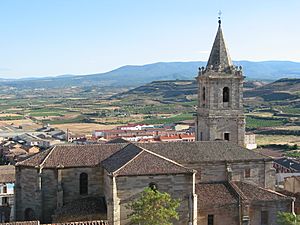 |
||
|
||
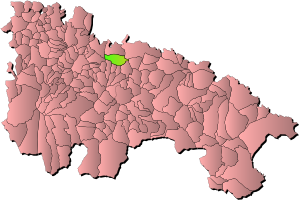
Location within La Rioja.
|
||
| Country | ||
| Autonomous community |
||
| Region | Rioja Media | |
| District | Comarca de Logroño | |
| Area | ||
| • Total | 28.49 km2 (11.00 sq mi) | |
| Elevation | 512 m (1,680 ft) | |
| Population
(2018)
|
||
| • Total | 2,952 | |
| • Density | 103.62/km2 (268.36/sq mi) | |
| Time zone | UTC+1 (CET) | |
| • Summer (DST) | UTC+2 (CET) | |
Navarrete is a lovely town in La Rioja, a region in Spain. It's known as a Conjunto Histórico-Artístico, which means it's a special place with lots of history and important old buildings. Navarrete sits right on the French Way, a very famous path that pilgrims have walked for hundreds of years as part of the Way of St. James. Today, Navarrete is also famous for its pottery, being the only pottery center in La Rioja and a big one in Northern Spain.
Contents
Navarrete is a town that covers about 28.49 square kilometers. It shares borders with several other towns. To the north, you'll find Fuenmayor. To the east, it borders Logroño and Lardero. If you go south, you'll reach Entrena, Medrano, Hornos de Moncalvillo, and Sotés. To the west, it's next to Huércanos and Cenicero.
| Northwest: Fuenmayor and Cenicero | North: Fuenmayor | Northeast: Fuenmayor and Logroño |
| West: Cenicero and Huércanos | Navarrete, La Rioja | East: Lardero |
| Southwest: Sotés | South: Hornos de Moncalvillo and Medrano | Southeast: Entrena |
Most of Navarrete's land is on a gentle slope formed by the Iregua River. The Daroca River flows through this area now. There's also a reservoir called Valbornedo in the town's area. The oldest part of Navarrete is built on a hill called Tedeón, which is 512 meters high. The town has grown outwards from this hill.
Farming and Wine
Rioja wine is a very important part of Navarrete's economy. The region is famous for its vineyards and delicious wines.
Navarrete is well-known for its pottery. Some old pottery workshops can still be found in the higher parts of town. However, most of the pottery making has moved to the lower areas, closer to the main roads. This makes it easier to transport the pottery.
The exact meaning of the name Navarrete is a bit of a mystery. The town was founded by the King of Castile. This was part of a plan to protect his borders. The name might be connected to the nearby Kingdom of Navarre.
One idea is that "Nafarrate" in the Basque language means "Door of Navarre." Over time, as Spanish became more common, the name changed to Navarrete.
Around the year 1192, King Alfonso VIII of Castile asked people from smaller, older villages to move to a safer, more protected spot. These villages were called Corcuetos, and their names were San Llorente, San Antolín, San Pedro, and Nuestra Señora del Prado.
These villagers settled around a castle built on Tedeón hill. This is how the new town of Navarrete began. The castle was strong and had a small wall around the settlement. This wall helped protect the town from possible attacks from the north.
Special Privileges
In 1192, Navarrete was given important fueros, or special rights, by the king. These rights allowed the people to share river water and use grasslands and woods together. The charter also let them set up local markets and fairs. Thanks to these special privileges, Navarrete became a very important town.
In 1367, a big battle happened near the town. It's sometimes called the Battle of Navarrete, but it's more famously known as the Battle of Nájera.
The historic center of Navarrete is a protected area called a Conjunto histórico. This means it has many important old buildings and a special historical feel.
Important Buildings and Sights
- Parish Church of the Assumption (Asunción de María): This beautiful church started being built in 1553 and was finished in the 1600s. It has three main sections inside and a fancy Baroque altarpiece.
- Hermitage of Santa Maria del Buen Suceso: This small church is located south of the town, towards Entrena. Its front has carvings that tell stories about the travelers on the Way of St. James.
- The Castle: This is the name given to the highest point of the Cerro Tedeón hill. There used to be a castle here, but no parts of it remain today. From this spot, you can enjoy amazing views of several towns and mountains around Navarrete.
How Navarrete's Population Changed in the 20th Century
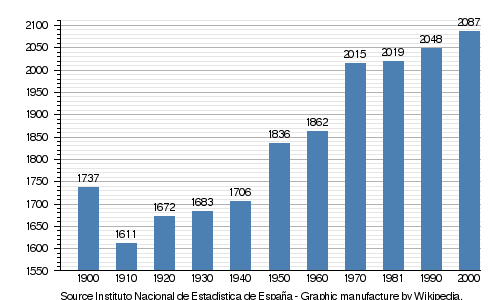
See Also
 In Spanish: Navarrete para niños
In Spanish: Navarrete para niños



